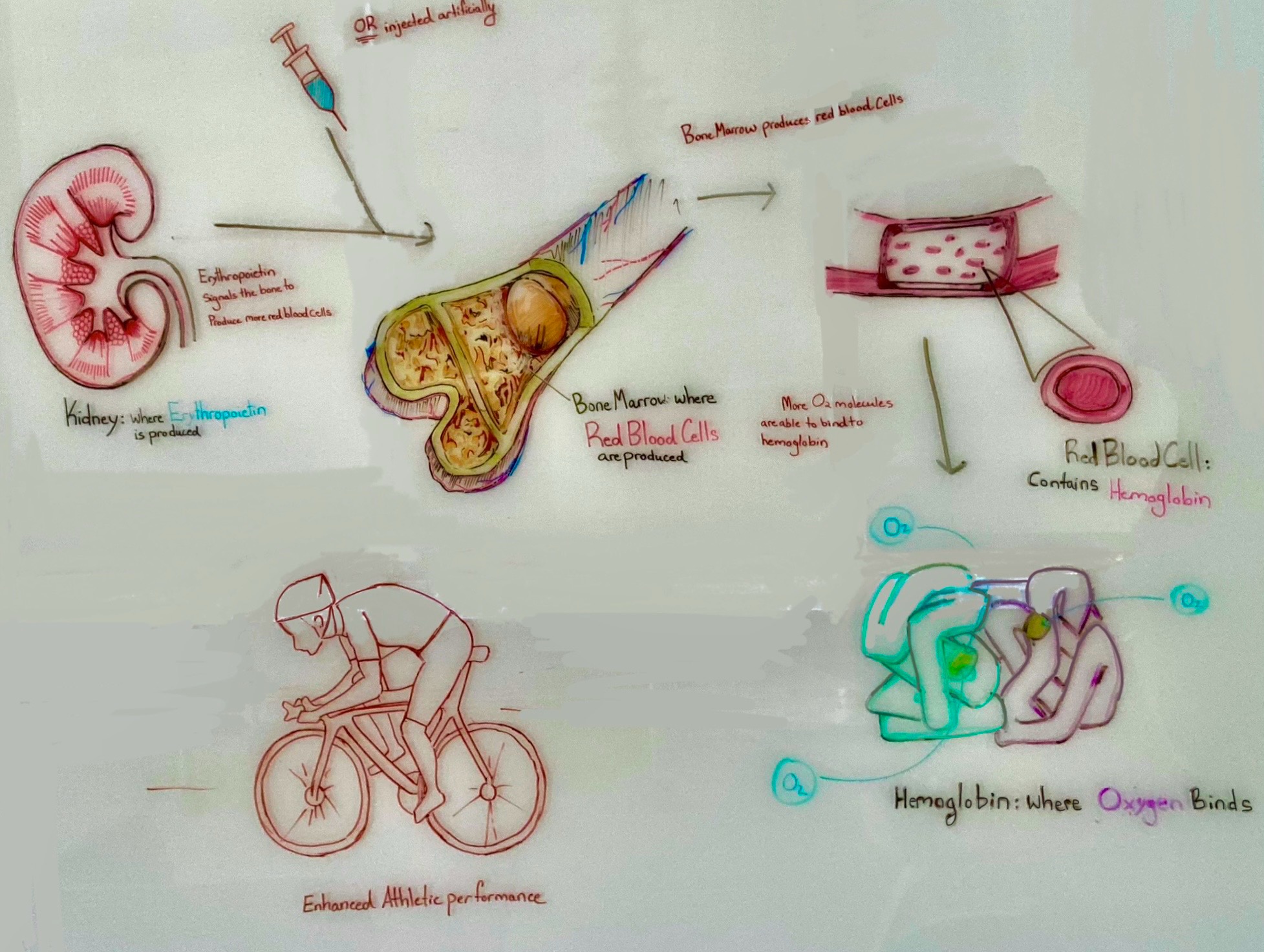Human beings are competitive by nature. Since ancient times, we have engaged in activities that allow us to express this competitive spirit. As sports have become increasingly prestigious, the pressure to perform at a high level has only increased. Athletic integrity has never been more of an issue, especially with the advancement of medicine. I chose to research blood doping and how this method of performance enhancement affects the body’s ability to provide more oxygen to the muscles. Understanding the body’s physiological responses to blood doping is crucial in the field of sports sciences, as it provides a deeper insight into how our muscular and circulatory systems function to accommodate the physical excretion we place them under. I used expo markers to visually represent how the injection of erythropoietin, a commonly used performance-enhancing hormone, increases the amount of red blood cells in the body, allowing for more efficient oxygen transport to muscle tissue.
While there are many ways in which athletes may artificially boost their performance, I will be focusing on blood doping. The term doping encompasses several techniques designed to enhance athletic performance by amplifying the blood’s oxygen-carrying capacity, including transfusion, recombinant human erythropoietin (rHuEpo), and erythropoietin stimulants j(Atkinson et al., 2020). Hemoglobin is a protein in the blood vital for delivering oxygen to tissues. Each hemoglobin subunit contains a heme group with an iron atom center. Oxygen is able to reversibly bind to iron in its redox state; however, when oxidized, the iron loses an electron and will no longer bond to oxygen (Pittman,2011). The unloading of oxygen molecules is induced by low pH, known as the Bohr effect. Hemoglobin undergoes allosteric regulation resulting in a reduced affinity for oxygen when there is a high concentration of H+ and CO2 (Webb et al., 2022). Metabolically active tissues have a low pH and, therefore, receive oxygen from the blood to compensate for their deficiency (Atkinson et al., 2020). Temperature is another factor that influences oxygen binding. Higher temperatures and hemoglobin affinity for oxygen allow it to be unloaded more easily (Pittman,2011). When we exercise, our muscle tissue’s temperature rises and allows oxygen to be easily unloaded in the muscles. Blood doping involves the alteration of oxygen affinity, aiming to increase affinity and improve athletic performance, as a reduction in oxygen affinity would result in poor performance (Atkinson et al., 2020). The enlargement of red blood cells can also increase the efficiency of oxygen delivery to tissue, resulting in a similar improvement (Atkinson et al., 2020).
As previously mentioned, there are several methods of blood doping. Allotransfusion was the earliest reported method but is less common nowadays. It involves blood transfusion from a donor (Atkinson et al., 2020). In comparison, autologous transfusion does not require a do not. Instead, the individual receives a blood transfusion after storing it (Grau et al., 2022). This method is much more widespread because it is safer and difficult to detect. The most common form of blood doping involves the misuse of recombinant human erythropoietin (rHuEPO). Erythropoietin is naturally produced in the kidneys and is vital to hematopoiesis, synthesizing red blood cells in bone marrow (Robinson et al., 2006). We are constantly producing erythrocytes, and this production is increased when necessary to compensate for blood loss. Erythropoietin (EPO) is mainly produced in the kidney and is stimulated by hypoxia or insufficient oxygen levels in tissue (Atkinson et al., 2020). As the kidneys detect low oxygen levels, they secrete EPO, which reaches the bone marrow, producing erythrocytes (Robinson et al., 2006). Aside from the moral indecency of doping, there are many reasons not to engage in this practice. The health risks associated with the use of performance enhancers such as EPO can lead to serious physical harm. While capable of improving aerobic capacity, increasing red blood cells can cause blood clots, heart attacks, and strokes (Atkinson et al., 2020). These potential health risks should be a cause for concern for anyone considering blood doping.
Thomas S. Atkinson, Marc J. Kahn, Blood doping: Then and now. A narrative review of the history, science and efficacy of blood doping in elite sport, Blood Reviews, Volume 39, 2020, 100632, ISSN 0268-960X, https://www.sciencedirect.com/science/article/pii/S0268960X19301468
Webb KL, Dominelli PB, Baker SE, Klassen SA, Joyner MJ, Senefeld JW, Wiggins CC. Influence of High Hemoglobin-Oxygen Affinity on Humans During Hypoxia. Front Physiol. 2022 Jan 14;12:763933. doi: 10.3389/fphys.2021.763933. PMID: 35095551; PMCID: PMC8795792.
Grau M, Zollmann E, Bros J, Seeger B, Dietz T, Noriega Ureña JA, Grolle A, Zacher J, Notbohm HL, Suck G, Bloch W, Schumann M. Autologous Blood Doping Induced Changes in Red Blood Cell Rheologic Parameters, RBC Age Distribution, and Performance. Biology (Basel). 2022 Apr 23;11(5):647. doi: 10.3390/biology11050647. PMID: 35625375; PMCID: PMC9137932.
Pittman RN. Regulation of Tissue Oxygenation. San Rafael (CA): Morgan & Claypool Life Sciences; 2011. Chapter 4, Oxygen Transport. Available from: https://www.ncbi.nlm.nih.gov/books/NBK54103/
Robinson N, Giraud S, Saudan C, Baume N, Avois L, Mangin P, Saugy M. Erythropoietin and blood doping. Br J Sports Med. 2006 Jul;40 Suppl 1(Suppl 1):i30-4. doi: 10.1136/bjsm.2006.027532. PMID: 16799100; PMCID: PMC2657498.

